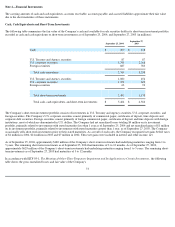Apple 2004 Annual Report Download - page 68
Download and view the complete annual report
Please find page 68 of the 2004 Apple annual report below. You can navigate through the pages in the report by either clicking on the pages listed below, or by using the keyword search tool below to find specific information within the annual report.
NOTES TO CONSOLIDATED FINANCIAL STATEMENTS
Note 1—Summary of Significant Accounting Policies
Apple Computer, Inc. and subsidiaries (the Company) designs, manufactures and markets personal computers and related software, services,
peripherals and networking solutions. The Company also designs, develops and markets a line of portable digital music players along with
related accessories and services including the online distribution of third-party music and audio books. The Company sells its products
worldwide through its online stores, its own retail stores, its direct sales force and third-party wholesalers, resellers and value added resellers. In
addition to its own hardware, software and peripheral products, the Company sells a variety of third-party hardware and software products
through its online and retail stores. The Company sells to education, consumer, creative professional, business and government customers.
Basis of Presentation and Preparation
The accompanying consolidated financial statements include the accounts of the Company. Intercompany accounts and transactions have been
eliminated. The preparation of these consolidated financial statements in conformity with U.S. generally accepted accounting principles requires
management to make estimates and assumptions that affect the amounts reported in these consolidated financial statements and accompanying
notes. Actual results could differ materially from those estimates. Certain prior year amounts in the consolidated financial statements and notes
thereto have been reclassified to conform to the current year presentation.
Typically, the Company's fiscal year ends on the last Saturday of September. Fiscal years 2004, 2003 and 2002 were each 52-week years.
However, approximately every six years, the Company reports a 53-week fiscal year to align its fiscal quarters with calendar quarters by adding
a week to its first fiscal quarter. The Company expects to add this additional week in its first fiscal quarter of 2006. All information presented
herein is based on the Company's fiscal calendar.
Financial Instruments
Cash Equivalents and Short-term Investments
All highly liquid investments with maturities of three months or less at the date of purchase are classified as cash equivalents. Highly liquid
investments with maturities greater than three months are classified as short-term investments. Management determines the appropriate
classification of its investments in debt and marketable equity securities at the time of purchase and reevaluates such designation as of each
balance sheet date. The Company's debt and marketable equity securities have been classified and accounted for as available-for-sale. These
securities are carried at fair value, with the unrealized gains and losses, net of taxes, reported as a component of shareholders' equity. The cost of
securities sold is based upon the specific identification method.
Financial Instruments with Characteristics of Both Liabilities and Equity
On May 15, 2003, the Financial Accounting Standards Board (FASB) issued Statement of Financial Accounting Standards (SFAS) No. 150,
Accounting for Certain Financial Instruments with Characteristics of Both Liabilities and Equity
. SFAS No. 150 requires issuers to classify as
liabilities (or assets in some circumstances) certain freestanding financial instruments that embody obligations for the issuer and have
characteristics of both liabilities and equity. The Company adopted the provisions of SFAS No. 150 on June 29, 2003, which resulted in a
favorable cumulative-effect type adjustment of approximately $3 million. This adjustment related to a forward purchase agreement that allowed
the Company to acquire 1.5 million shares of its common stock at an average price of $16.64 per share for a total cost of $25.5 million. The
Company settled this forward purchase agreement in August 2003, which resulted in an additional gain of
64
























